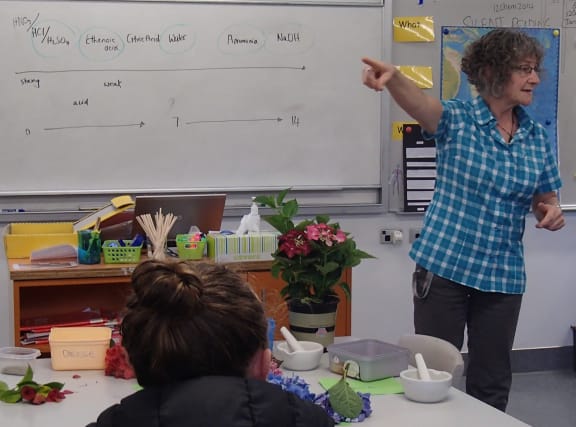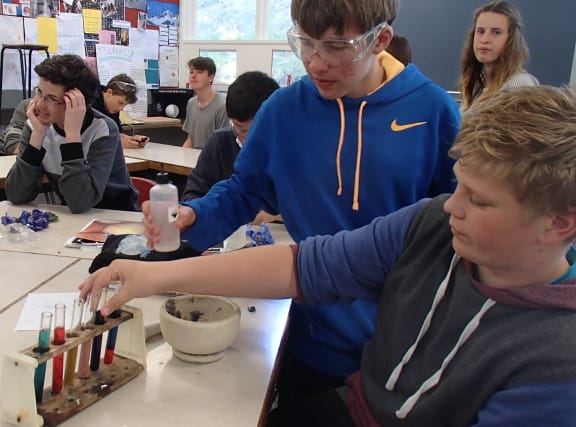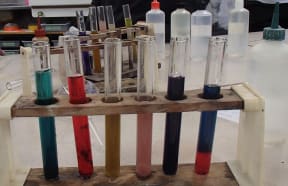By Alison Ballance

Science teacher Terry Burrell, from Onslow College in Wellington, has won the 2014 Prime Minister's Science Teacher prize. Photo: RNZ / Alison Ballance
“It’s frightening to think that we might be switching lights on – or off – for kids, and that’s a huge responsibility for a teacher to hold. But it’s also very exciting.” Top science teacher Terry Burrell says life experience and some awesome teachers are what inspired her love of science, and she hopes that she might also be an inspiring teacher for the next generation of budding scientists.
Last week, Terry Burrell, who is the Learning Area Leader for Science at Onslow College, in Wellington won the 2014 Prime Minister’s Science Teacher prize. The prize is worth $150,000, and the judges described Terry as having ‘an infectious love of learning which stimulates both students and other teachers to perform at their best’.
“Even now when I go into a Year 9 or 10 class I very much put myself in there with them as a learner” says Terry. “The day I stop learning is the day I stop teaching. But every time you teach something you unpick a little more, and you make connections between it and the rest of the world, the rest of your knowing, and that’s what brings you back to it again and again with fresh eyes – and that’s the buzz of teaching.”

Year 10 students at Onslow College carrying out their experiment with acids and bases. Photo: RNZ / Alison Ballance
Terry says that the language of science can be quite intimidating for students, and she puts a lot of effort into demystifying it and explaining it in terms that the students can grasp. “That ability to unpick and unpack the language of science can be quite empowering for them.”
Terry believes it is vital for students to understand how science works, for many reasons.
“I challenge you to find me a job that doesn’t involve science,” she says, noting that even a job like chef involves food chemistry. “There are also some really wicked problems out there that they need to be able to see into … and they need to be able to tell science from pseudoscience. We talk about them needing to have bullshit detectors.”
2014 Prime Minister's Science Prizes
The 2014 Prime Minister’s Science Prize was awarded to the He Kainga Oranga/Housing and Health Research Programme, led by Philippa Howden-Chapman from the University of Otago. The 28-strong collaboration has worked on the relationship between housing and health, showing that warm dry houses have many health benefits. Philippa Howden-Chapman has been on Our Changing World before,talking about the heatsmart programme.
The Prime Minister’s Science Media Communication Prize went to ‘Nanogirl’ Michelle Dickinson, who runs New Zealand’s only nanomechanical testing laboratory at the University of Auckland, and also teaches kids that science doesn’t have to be boring or take place only in the classroom.
The Prime Minister’s MacDiarmid Emerging Scientist Prize went to University of Otago researcher Karl Iremonger, who has discovered a new brain cell structure and communication system, setting the stage for more targeted therapies for neurological diseases,
The Prime Minister’s Science Teacher Prize was awarded to Onslow College’s Terry Burrell.
Last week on the programme we featured an interview with Nanogirl Michelle Dickinson, who won the 2014 Prime Minister’s Science Media Prize.

In this classroom science experiment Year 10 students liquified different colour flowers, and then added acids and bases to observe what happened to the colour. Photo: RNZ / Alison Ballance

